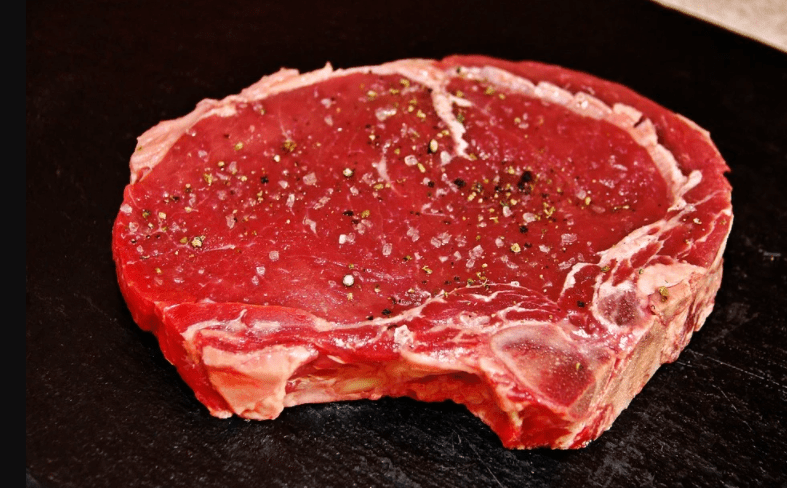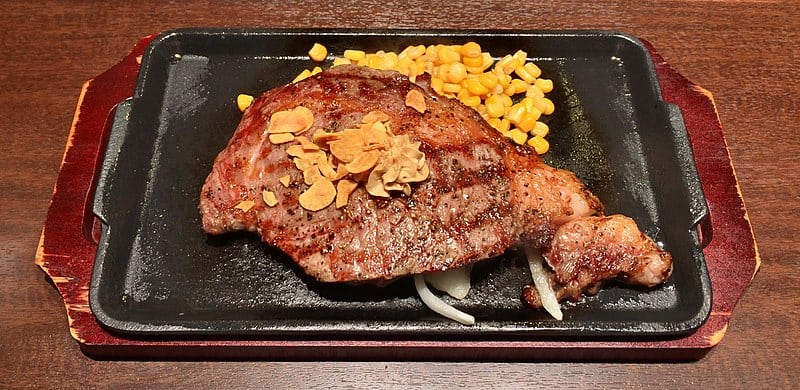- Weber Q2200 vs Q3200: My Take - May 2, 2024
- Where to Buy Meat Online: 12 Best Meat Delivery Services - April 12, 2023
- Stock Yards Review: Will Their Meat Meet Your Expectations? - April 12, 2023
If you’re looking for perhaps the best cut of steak you can get, you’ve come to the right place.
I’m from Kansas City, and if there’s anything we know better than meat, well, I don’t know what it is. Aside from barbecue, we have the best steak in the world.
But not all steak is treated equally. You can’t just toss any old steak on the grill and expect it to turn out tender, juicy, and delicious. You have to know what cuts to look for, how to season them, and at what temperature they should be sizzled to perfection.
Aside from the Kansas City Strip (my personal favorite), the filet mignon and the ribeye are two of the most well-known and well-loved cuts of steak. Tender and juicy, these cuts are delicious and flavorful.
However, they don’t have much else in common.
Main Differences Between Filet Mignon and Ribeye
The main differences between filet mignon and ribeye are:
- Filet mignon has a velvety smooth texture that melts in your mouth, whereas ribeye is rich and hearty.
- Filet mignon is very small and expensive, whereas ribeye is slightly larger and inexpensive.
- Filet mignon has a mild flavor, whereas ribeye has a very meaty flavor.
- Filet mignon is best served at medium-rare, whereas ribeye is delicious from medium-rare to medium-well.
- Filet mignon is low in fat and not prone to flares, whereas ribeye’s fat content makes it prone to catching on fire quickly.
ButcherBox delivers 100% grass-fed beef, free-range organic chicken, humanely raised pork, and wild-caught seafood directly to your door. Sign up today!
What is Filet Mignon?

The term ‘filet mignon’ is French for ‘dainty fillet.’ This is à propos (that’s French for appropriate), given that it’s very small and incredibly tender. The tenderloin is a long, thin, cone-shaped muscle that extends from the ribs to the sirloin, and it’s rarely used, so it’s not tough and contains very little gristle or connective tissue.
The filet mignon comes from the smallest section of the tenderloin that’s cut into even smaller parts. Each tenderloin can produce anywhere from 10 to 12 filet mignons from the average cow.
This piece of meat is by far the most tender on every cow, and it has an almost buttery texture throughout. This indulgent texture coupled with the small size makes it the scarcest and most expensive piece of meat available.
Many people are fooled into thinking this is simply the best cut of steak out there, based on its high price, but the low-fat content usually means low flavor, too. You can spice it up by wrapping it in bacon or smothering it in gravy, but alone, there’s not much to it.
However, even without those extra touches, many connoisseurs will pay this top dollar for superior tenderness that practically falls apart on a fork.
Filet Mignon Appearance
Filet mignon is a very small cut. It’s round and thick, and typically only 6-8 ounces in weight.
While it can vary in size depending on where you get it, it’s generally one half to one quarter the size of other cuts, if not even smaller.
A filet mignon is a fine-grained muscle. Remember, it’s a rarely-used muscle, so its fine grain is crossed with very thin strips of fat. You’ll recognize it by it’s small, round shape and almost zebra-like fat striping.
Filet Mignon Texture
Because the tenderloin muscles are so rarely used, they’re very tender. Hence the name tenderloin. It’s a tender loin. Get it?
It would be apt to describe this cut of meat as having a melt in your mouth sort of texture. There’s very little connective tissue or fat and no hard or chewy parts to work through.
Ideal Filet Mignon Taste
The taste of the filet mignon is mild, but that’s not always a bad thing. Many people don’t like the strong flavor of beef.
The tame flavor also enables it to go well with many other flavors, so it pairs nicely with all kinds of other foods.
The other nice thing about filet mignon is that because of the low-fat content, it tends to be much less greasy than other cuts of meat.
How Much Does a Filet Mignon Cost
This is where the filet mignon will get you. Filet mignon is a very small cut from a very small part of the cow, so it’s rare and expensive. It costs more than most other cuts of steak out there.
However, that doesn’t mean it’s the best. You have to know what you like before you can determine whether or not it’s worth the cost.
Best Filet Mignon Portion Size
Common serving sizes for filet mignon are about 6 or 8 ounces. A butcher can typically get about six 8-ounce filet mignons from the tenderloin if he cuts them two inches thick. This is usually an ideal size.
They’re rarely any bigger or smaller than that because otherwise, they wouldn’t cook properly.
How to Grill a Filet Mignon
It’s tougher than you think to get that gorgeous filet ready for the hot grill. You can’t just plop it on there straight from the fridge or it won’t cook properly. It should rest on the counter for 20 or 30 minutes first. Make sure you lose some of that chill from the refrigerator, but you shouldn’t have to trim it at all.
The mild flavor of the filet mignon is enhanced by a little salt and pepper before cooking, but if you want it to be a bit more flavorful, you can take it to the next level with a dry rub or a light marinade. One thing to keep in mind is that because this cut is already so tender, marinating for too long can make it extra mushy.
How to Cook a Filet Mignon
Filet mignon is best when cooked no more than medium-rare. If the idea of red meat irks you, filet mignon may not be the cut for you, but certainly don’t knock it before you try it. The trick is to cook it hot and fast over direct heat.
Set up your grill with two zones. You should have a hot side and a cooler side. Warm the direct heat side up to medium-high and put the filet directly on it. For thinner filets, sear for two minutes on each side. For thicker filets, sear for up to four minutes on each side.
Once you’re finished searing on both sides, move the filet to the indirect heat to finish it. While sometimes you can use a timer or your intuition, for something as delicate as a filet, you really need to measure the temperature to tell if it’s done.
Using a digital probe thermometer, you can measure medium-rare at 130℉. However, it’s best to remove it from the grill around 125℉ and let it rest for 5 or 10 minutes as it rises to 130℉.
If you’d rather cook it in a pan on the stove, you can sear it with a small amount of oil. Use the leftover oil in the pan after cooking to pour over the top for extra flavor.
Because the filet is so low in fat, it can dry out easily, so cook it on medium-high heat quickly. Adding the oil back to the top also gives you extra moisture.
Filet Mignon Benefits
- Tender and juicy
- Easy to cook
- Pairs well with many other foods
Filet Mignon Disadvantages
- Expensive
- Mild flavor
What is a Ribeye Steak?

The ribeye is also aptly named for the part of the cow from where it comes. It’s taken from the rib and the swirl of fat that marbles in the middle resemble an eye. Depending on the way the beef is cut, a ribeye may or may not have a bone.
The ribeye comes from the same section as a prime rib roast, but rather than cooking it as a whole roast, it is cut into separate steaks.
Ribeyes steak can also contain different muscles, like the spinal, dorsal, or long muscles, depending on how they’re cut. It can be a mixture of both tender and tough meat with beautiful marbling of fat and connective tissue, giving it excellent, juicy flavor.
A ribeye resembles the epitome of steak flavor for many steak lovers because all it needs is a bit of salt and pepper to bring out the fantastic natural flavor.
Ribeye Appearance
A ribeye is generally cut at between 8 and 12 ounces and about an inch to an inch and a half thick At a glance, it is marbled with fat and tissue, which adds great flavor, and when cooked properly, is not chewy or hard to eat.
You will also see white spots of fat throughout as well as thick strips of fat on the edges.
Ribeye Texture
The fat content of the ribeye can make it a bit tougher to chew, but because it’s so flavorful and juicy, when cooked correctly, it’s also very tender. It won’t be as tender as a filet mignon, but it is still a much softer piece of meat than many other cuts of beef.
Ideal Ribeye Steak Taste
Ribeye steaks have a very meaty taste. Because the muscle is exercised more, it develops more taste. This strong muscle is rich and fleshy and will dominate everything else on the plate.
That doesn’t mean you can’t serve it with something else flavorful, but the flavors should complement one another rather than compete.
How Much Does a Ribeye Cost?
While the ribeye isn’t the cheapest cut of beef, it’s not nearly as expensive as the filet mignon. If you love the flavor of steak, you’re getting your money’s worth with this one for sure.
Best Ribeye Steak Portion size
While a 6-ounce portion of ribeye might be sufficient, common serving sizes at restaurants include anywhere from 8 to 12 ounces. Because it’s so hearty, it’s very filling and doesn’t tend to need a lot of sides to go with it.
You’ll be happy with a small portion of potatoes or green beans and a glass of red wine.
How to Grill a Ribeye Steak
Your ribeye should be one inch thick at a minimum. 1.25 to 1.5 inches is perfect for a great mouthfeel. They’ll cook up easier and have better flavor as well.
Try not to trim them too much because cooking them with the fat on them will give them great flavor and maintain the juicy quality you love. If there are some protrusions of fat that will obviously char, you can trim those back, but don’t completely cut them off.
Let your steak rest on the counter for 30-60 minutes before cooking to let the chill off. Cooking them on the grill straight out of the refrigerator can cause uneven cooking and a loss of flavor or juice.
You don’t need to help your ribeye along in the flavor department. Just some salt and pepper is fine. If you want to do a little something extra, skip the marinade and give it a little boost with a dry rub instead.
How to Cook a Ribeye Steak

To cook a ribeye steak in your own backyard, set up two-zone cooking space on your grill. Set up one burner to medium-high heat and turn on a low flame on the other part of your grill. If you’re using charcoal, slide the coals to one side to make it hotter than the other.
Once the grill is warm, place your ribeyes directly over the heat and let them sear for 4-5 minutes on each side.
For those of you who like your steaks medium-rare, you’re done. You can check your meat with a probe thermometer to ensure a 125-130℉ read before removing them completely and letting them sit. Keep in mind that the carry-over cooking will nudge a bit more pink out of your meat.
If you like your meat with less pink, you can move your ribeyes over to the low-temperature spot and finish cooking them without burning the surface.
Keep in mind that as you’re cooking, the fat will dissolve, but it can also catch fire very quickly. Monitor your ribeyes very closely to prevent flare-ups, which will burn the outside of your steak.
Ribeye Steak Advantages
- Inexpensive
- Hearty and flavorful
- Beautiful marbling
Ribeye Disadvantages
- Can be fatty and chewy
- Flares up on the grill
Filet Mignon vs Ribeye Comparison Chart
| Filet Mignon | Ribeye | |
| Size | Small | Medium to large |
| Meat content | High | High |
| Fat content | Low to moderate | Moderate to high |
| Weight | 6-8 ounces | 8-12 ounces |
| Servings per cut | 1 | 2 |
| Location on cow | Center of tenderloin | Upper central ribs |
| Calories (3oz serving) | 190 | 170 |
| Saturated fat (3oz serving) | 4 grams | 2.8 grams |
| Protein (3oz serving) | 23 grams | 26 grams |
| Zinc (3oz serving) | 5 mg | 3.9 mg |
| Iron (3oz serving) | 2.2 mg | 3 mg |
FAQs
If you’re working steak night into the budget, you’re going to have to expect to spend a little money on good cuts. Both filet mignon and ribeye can be expensive, but you’ll find that filet mignon costs noticeably more.
That’s not to say you’re not getting your money’s worth. They’re tender and juicy. However, ribeye is loaded with rich, meaty flavor, so it’s well worth the cost, too.
Ah, the classic ‘which is better’ question. It’s all about your preferences. Yes, the filet mignon is an excellent steak. If you want something incredibly tender and juicy, then this is definitely the way to go. However, if you’re more partial to the robust flavor of a ribeye, you’ll still enjoy a tender steak when cooked appropriately, plus you’ll get an overwhelmingly juicy and rich flavor to go along with it.
If you’re standing in the grocer’s meat section and finding things called eye fillets, you might be quick to assume it’s the same as a filet mignon. However, the eye fillet is actually another name for the tenderloin, which is the part of the cow that the filet mignon comes from.
Perhaps you’re less concerned with how it tastes or what it costs and more concerned with which one might fit in better with your diet. In that case, your best choice is likely the filet mignon, although it depends on your goals.
The filet mignon has a higher protein content with less fat and fewer calories. However, it has less iron and more cholesterol.
Filet Mignon or Ribye: Which is Better?
It all depends on how you prefer your steak. Do you have a big, hearty, meaty appetite? You’ll enjoy a ribeye cooked to delicious perfection with its tender juiciness and robust flavor. Your wallet will be happy with the savings, too.
However, if you like to downplay your steak and enjoy a well-rounded meal with all of the trimmings, opt for the mild flavor and velvety, buttery texture of the filet mignon. You might pay a little more, but you won’t regret it.
Further Reading on Ribeye Steak
Here are some additional articles on ribeye steak vs different cuts:
- Ribeye vs Picanha Steak Compared
- Ribeye vs Porterhouse Steak Compared
- Ribeye vs T-bone Steak Compared
- Ribeye vs Sirloin Steak Compared
- Ribeye vs Prime Rib Steak Compared
- Ribeye vs Strip Steak Compared
- Ribeye vs New York Strip Steak Compared
- Ribeye vs Tomahawk Steak Compared
- Ribeye vs Chuck Eye Steak Compared
Further Reading on Filet Mignon
Here are some related articles on filet mignon steak:


